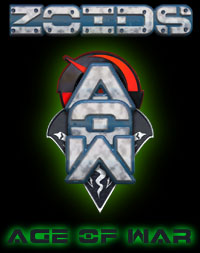RBOZ-030 PALADIN - 2007 Phenotype Contest Entry
This is truly a monster of a page; perhaps you should get some coffee...
CAST
Rainbow Jerk
Body, wings, legs, feet, head, tail, feathers
Jet Falcon
Wings
Aero Saurer
Feet, lower aft sensor array
Gojulas
Thighs, Thunderbolt cannon base, buoy racks, bots
Cannon Spider
Tumult missiles, Sea Streak torpedoes
Energy Liger
Chest sensor unit / torpedo mount
Gustav
Inner thigh bolts, Tumult missile boosters,
neck details
Buster Eagle
Skyslash missiles, underside wing details
Diablo Tiger
Wing sensor radomes
Red Horn
Wing topside sensor arrays,
HPR & Thunderbolt barrels
Elephander
Primary dorsal radome lift
Bamburian
Sensor Buoys, wing thruster arrays
Killer Dome
Wing sensor mounts, leg & neck hydraulic pistons, neck sensor rings
Firefox LTD
Primary radome bolt
Raykong
Neck detail
Deep Diver (sprue)
Missile hardpoints
CP-15
Rear talons
Kotobukiya HMM Molga
Wing turret Gatling cannons, pilot
NON-ZOID PARTS
AH-1 Cobra Attack Helicopter
Cockpit control consoles
G1 Transformer Grapple
Primary engine intakes
Struxx
Wing ball turrets
Bionicles
Neck structures &detail
BIC Ballpoint Pens
Legs, neck
USS Missouri
Neck detail
Asoblock
Neck joints, thigh radomes
Zenith radio speaker
Primary dorsal radome
SD Gundam
Head mounted antenna arrays, tertiary engine bells
Zip Ties
Towable antenna arrays (head feathers)
Lansang Earbud
Chest sensor array, Tail sensor array
Soft Soap Dispenser
Main engine housing & cowling / inner cone, secondary engine nozzle, neck radomes
Toothpase Cap
Outer primary engine nozzle
Coil Springs
Sensor array cable, leg & neck shocks
Serpentine Necklace
Spinal cable
Nylon Hinges
Talon joints, Primary dorsal radome lift,
Thunderbolt cooling coils
Polystyrene Card
Feathers, vents, beak, inner thigh armor, blade antennas
Polystyrene Tube
Neck & leg hydraulics
Paneling Nails
Leg hydraulic pistons
Steel Washers
Leg hydraulic pistons
Copper Tubing
Primary radome hydraulic
Necklace Beads
Quad-radome array
Toothbrush
Foot flexor hydraulics
Ben & Jerry's Ice Cream Spoons
Base neck armor
Video Tape Parts
Primary engine pylon supports


STORM HERON
Chassis: Great Blue Heron
Power Plant: RPZ-4a (Royal Power Zoid – Avian Class-4)
Primary Mission: A.W.A.C.S. Theater Observation
Secondary Mission: Sea/Land/Air Interdiction
Crew: 1 (minimum rank requirement: Captain)
Statistics - (flight mode)
Length: 42 meters
Width: 46 meters
Height: 10.2 meters
Mass: 80 tons
Performance
Air: MACH 1.6
Land: 110 KPH

ARMAMENT
The RPZ-212 Storm Heron should not be mistaken for a mere talented sensor system; it is designed to attack targets of opportunity and is well armed for that role. The Zoid carries ordinance and direct fire weapons for defensive purposes, as well, to enhance its theater survival probability and therefore ensure the success of its mission.
40mm HPR Laser Cannon (x2) – wing mounted, forward arc, fixed
Mounted near the elbow joint of each wings is a high-speed pulse laser used, predominantly, for firing at softer targets of opportunity, usually in the defensive role. These guns do light to moderate damage to avian Zoids and light armor but require little power or skill to use.
75mm “Thunderbolt” RAEC (x2) – wing mounted, forward arc, fixed
Far more formidable than the wing lasers, the Thunderbolt is classified as a RAEC (pronounced “rake”) weapon; Re-Accelerated Electromagnetic Cannon. It fires a gauss round that passes through an additional field system mounted just prior to the muzzle, adding terrible velocity. This weapon is designed to “crack” armored targets at up to 5 kilometers and can still maul units at twice that distance. The system requires a great deal of power and can momentarily blind some of the Storm Heron’s sensor systems and is therefore only used if there is no other unit available to strike the target. Each is also limited by carrying a magazine of 200 rounds.
“Fire-Rain” Beam Defense System (x2) – wing mounted, 360º arc, 70º inclination
Located on the upper surface of each wing is a large-bore ball turret, the Fire-Rain CWiS. Though it appears as a huge, 200mm aperture weapon, it is actually an automatic, 4-barrel, beam machinegun. It has a relatively short range (only 2 kilometers) but the spread of the beams can take down most incoming projectiles with minimal tracking. If turned against an avian Zoid the weapons can do considerable harm to “soft” surfaces within 1 kilometer.
“Tumult” Tactical Missile (x4) – wing mounted, forward arc, fixed
The heavy missiles carried by the Storm Heron have a range of more than 200 kilometers and may either self-guide to a designated target or may be handed off to be guided in by an allied unit. Each has an armor penetrator beneath the nose cowling and a high explosive warhead to rip most enemies apart. This missile is predominantly used against hardened installations or heavy ground or surface Zoids. A single round can bring down a Whale King transport with ease.
“Sea Streak” Air-Launch Torpedo (x3) – torso mounted, forward arc, fixed
Suspended beneath the chest of the Storm Heron are three torpedoes to enable strikes against submerged targets. These weapons may be dropped from 100 meters and will self-guide to any signal they are programmed to pursue at release. They have a range of 30 kilometers and achieve a submerged speed of 120 knots, making them deadly against most marine units.
“Skylash” Missile (x4) – wing mounted, forward/rear arcs, fixed
To help protect the RPZ-212 from aerial threats it can carry up to four air-to-air missiles. The Skylash missile is a fast and maneuverable weapon, able to shoot down aerial Zoids upwards of 50 tons at a range of 60 kilometers. It can be fired at ground units as well, but does somewhat limited damage do to the heavier armor. A unique aspect of the Skylash is that it may be mounted facing forward or aft on the bracket, allowing the Storm Heron to fire them to the rear if they are so equipped.
“Sea Spirit” Sensor Buoy/Tactical Mine (x12) – wing mounted, lateral arcs, fixed
Though primarily an extension of the Storm Heron’s sensor suite, the Sea Spirit buoy’s ability to track an incoming target and engage it as either a mine or a depth charge down to 1,300 meters earns it an entry in the arsenal of the RPZ-212. Damaging through concussive force, the enemy must be fairly close to the system; within 50 meters for any real effect. Still, within that range it can compromise the hardened fuselage of a Warshark or disable sensitive equipment on an Angstmorder.
Hardened Alloy Talons (x2) – leg mounted, integrated construction
Though not as deadly as the talons equipped on some Zoids, these are fearsome weapons, and with the great reach of the Storm Heron’s long legs, it can use them to great effect while keeping vital components out of the reach of most other melee combatants.
Hardened Alloy Beak (x1) – head mounted, integrated construction
Designed to tear through the heavy hulls of submersible Zoids, Storm Heron’s beak is also a deadly weapon in the hands of a competent pilot. Even worse than the claws, the long, agile neck of the RPZ-212 allows the Storm Heron to “fence” with its beak; though this can take a toll on all but the most skillful and enduring pilots.
HISTORY
As the Helic kingdom found itself pressed back towards the sea by the forces of the Empire, it began to rely more on aquatic units for defense, counter-attack and transport. While Sea Sabers were quick to manufacture and were effective fighters, they were short ranged and required a carrier such as the Whale King or the mighty Gallant Mariner to bring them into battle. Though seemingly indestructible, the Mariner and other large transport Zoids proved vulnerable to attack, and colonies with access to the open water were more so. Further, inland operations of the enemy were more difficult to coordinate against from installations at sea. Helic needed something to provide accurate intelligence above and below the waves, and also far inland, and could coordinate operations between theaters. An air unit was the natural choice.
CAPABILITIES
First and foremost, the RPZ-212 is designed as an intelligence gathering and communications platform. It was created to fly high above the theater of war (within the lower mesosphere), track everything that exists within it, and report it back to any friendly unit that can act on the information. With its extremely efficient power plant and broad wings, the Storm Heron can stay aloft almost indefinitely. It takes a special pilot to endure the missions that routinely last for 12 hours, oftentimes far longer. The Zoid is not a fighter, however, achieving a maximum speed of MACH 1.6 and having a severe lack of mobility. It can prove easy prey for enemy avian units, and thus often requires a distant fighter escort.
DEFENSES
Being a slower, more lumbering aerial Zoid, the Storm Heron relies primarily on its armor and ECM suite to preserve it. It has dense armor for a flier, able to take most light weapons in stride and even shrug off missile near-misses. It is still vulnerable to higher caliber cannons and missile strikes. Where the Storm Heron excels is in its ability to vanish from sensors or to create up to 6 “ghosts” of itself, confusing targeting systems. While the human eye can clearly see a single Heron, a targeting Zoid sees up to 7 of them. In this the Storm Heron can be manually targeted by Zoid pilots using direct fire weapons but the system does serve to confound missiles. For protection from incoming missiles, a 4-barrel close-in defense cannon is mounted on each wing. If pressed, the guns can target soft foes.
AI-2 PROFILE
Storm Herons, despite their size and appearance, are usually quite standoffish and somewhat cowardly. They resist getting closer than the maximum effective range of enemy artillery and often require escorts if a commander wishes to have one fly directly over a battlefield at any altitude. They do shed this aspect of fearfulness when they are engaged in their more instinctual role; interdiction of fish-type Zoids. A Storm Heron will gladly stalk and destroy an enemy shark or fish Zoid, even two or three of them, but they get flighty again if there is a school close by.
SUMMARY
RPZ-212 Storm Herons are few and far between but are so effective at their roles that the kingdom of Helic seldom needs more than a handful operational at any one time. While limited in their combat capabilities they have established themselves as indispensable to the Helic warfare network and are the foundation of the RMA-33 Sea Rakers, the Royal Maritime Airwing's elite forward recon wing. Together with air, sea, and land forces, the RPZ-212 Storm Heron and its variants are a force to be reckoned with.
WORK & PLAY MEET AT LAST
It all started out so innocently; stretch the legs and neck of a Rainbow Jerk to make a Heron. I wanted to make a Zoid of an animal I had not seen built before. An animal that represented my home; the beautiful Great Blue Herons common to the Pacific Northwest in Washington State. I also wanted to honor the Navy personnel at the base where I grew up, whom I now serve professionally; mostly with the sub-hunter P-3 and E-P3 Orion squadrons. It was a perfect match, actually... the heron is a fish hunting bird, and the P-3 a submarine hunting plain. It would prove to be at least as difficult a build as the Zoid I still consider my masterwork; the EZ-501 Fusillade centipede/battleship.
THE BODY
When I decided to build a heron Zoid I immediately began looking for a chassis with the most compatible form. I examined Buster Eagle, Jet Falcon, and Salamander most closely, since they were in large supply. Buster Eagle had the most appropriate parts, but a Blox body is never my style. Jet Falcon could be worked, but it was too jet-like for my needs and the body was inflexible. Salamander... it didn't take long to decide against it. That led me to Rainbow Jerk. I had one and never really liked it; the only non-Blox Zoid without a motor. And, without some serious paint work, I just can't get into the peacock colors alongside my collection of war machines. Early on I realized that it had a very heavy body and complex inner workings that would ultimately hinder the final model. I reduced the weight of the Jerk's body by 25% by carving out the innards. As more parts were applied using kneaded eraser as a temporary glue, I started to like what I saw. The tail fins were sawed off, the neck bulked up. I wanted to emulate real military search and destroy aircraft, so I began working on a series of blade antennae and radomes. These, mounted atop a spare Energy Liger lower mane, ended up simulating the long, angled feathers of the blue heron perfectly! It also made it extremely difficult to touch the model!
LEG CONSTRUCTION
It was actually quite a challenge to design new legs. At first I just wanted to stretch Rainbow Jerk's existing legs, but it was obvious they would be too long and spindly, and the thigh was tiny! I had a pair of Bic pens that I wanted to use for the legs; the shape had a grooved grip that appeared like a cross between shocks and vents. The entire Jerk leg ended up merely securing the pen in place, the old hip would become the new knee. For a hip, I used the forearm of a Gojulas... the proportions were perfect! The foot, however, was another problem! Herons have long toed feet to support their weight, and I ended up combining the toes of an Aerosaurer and the Rainbow Jerk to build them. I wanted them to flex, so I used nylon A/C airplane hinges. To support the new size and growing weight, the rear toes had to be extended. I used supports from a CP-15 missile launcher and placed the claws on them, again, using flexible hinges.
THE NECK
I tried to hold off from doing the neck for as long as I could. The neck of the blue heron is very flexible and is held in some very specific poses in both flight and landed modes. On the ground, the neck of the blue heron is held in an "S" shape, and in flight the neck becomes more of a "U" shape. I chose to use another pair of Bic pens that matched those of the legs to help unify the design. These were sandwiched between various bits, including Bionacles and plastic ice cream spoons. The joints were created with Asoblocks (which I must soon acquire more of, since I'm running out!) because they are heavier and thicker than tiny and hard to use Blox pieces. Smaller bits were included to add details to the neck sections. The second segment also has a stainless steel piston, spring threaded hydraulic to match the legs.
WEAPONS
I can no longer seem to use just stock weapons from Zoid and model kits. If there was only one weapon the Heron would carry, it would be long range tactical missiles. These were made by cutting missiles from Cannon Spider in half, mounting the fronts upon a drilled out Salamander bolt. Five slots were cut in the missile body, which is a little tough because it is a soft, flexible plastic. Four of these were filled with scratch cut styrene fins, the last is used to mount the missile to the launch rail. Four rails were made using the tabs from a sprue tree. The tabs were glued to the bottom of the inner wing, where a gap is filled with vent-grooved styrene and the screw holes are filled and filed smooth. I added four anti-aircraft missiles but taking the Buster Eagle's twin missile and cutting the mount out, filling and polishing them into individual rounds. I sanded the four mounting pegs under the Jet Falcon wings into tabs, then cut slots into the new missiles to mount them. A shaved Struxx ball joint was capped with a Bionacle pin to create the defense turret, and the HMM Molga 4-barrel gatling gun was mounted inside the shroud. Finally, I took a medium sized Zoid cannon from a Red Horn kit and cut it in half. The barrel was fitted to the original (teeny tiny) gun on the Jerk's wing, making a nice, long weapon. The back half of the gun was then flipped around, bored out on the rear (now the front) and mounted to a peg cut from the Gojulas forearms now used as Heron's thighs. I cut out the bottom of the gun and mounted a piece from a nylon hinge as a magnetic coil. This gave the Heron a decent heavy direct fire weapon.
CAPABILITIES - (continued)
The most important piece of equipment on the RPZ-212 is the ODA-25.FR, also known as the Dark Dome Array. It can observe virtually every active unit within 1,000 kilometers and track them. Inactive units are still detected 50% of the time as well, as are heavy infantry and camouflaged structures. The Storm Heron’s communication abilities are just as impressive. It can relay information to all allies active in its range simultaneously, or determine which specific allies will receive transmissions. It can intercept communication signals, decrypt them, and transmit re-encrypted code within common navigational data, preventing an enemy from knowing they have been compromised. Further, the RPZ-212 can accept or retask any “handoff” weapon systems, taking over the tracking and guidance of missiles and projectiles of allied units or transferring control of them to allies.
CAPABILITIES - (continued)
To better discover, track and target submerged units, the Storm Heron carries 12 sensor buoys beneath its wingtips. These may be dropped into the water from 500 meters. The buoys locate almost any target within 50 kilometers and transmit all necessary data to the Heron. They, themselves, are difficult to track and target as each carries a passive ECM pod and is coated with an SDM (Sensor Defeating Material) skin. Finally, if an enemy is within 10 meters of the buoy, the RPZ-212 can set it to detonate as a sea mine, or allow it to sink prior like a depth charge. This prevents the technology from falling into enemy hands as well as offers the Storm Heron a chance to remotely destroy additional enemy units.
HISTORY - (continued)
At first Helic engineers sought to modify existing units for the role, most notably the venerable Salamander and the far reaching Buster Eagle. Existing Zoids could not fulfill the requirements for aloft time, stealth, communications and weapon loads, however. A new Zoid was proposed from Genesis Avionics, the contractor responsible for the GZ-011 Rainbow Jerk, a formidable scout/transport Zoid with adequate weaponry. This new unit was based in part on its predecessor, but only 10% of the framework remained unchanged. At the end of development the RMA (Royal Marine Airwing) took possession of the RPZ-212 Storm Heron; the perfect machine for the mission.




CAPABILITIES - (continued)
Storm Heron is lumbering in the sky, yet adept at its mission. It functions similarly on the ground. The long, reinforced leg structures carry redundant hydraulics and shocks, allowing it to alight on solid turf and wade in waters up to xxx fathoms. The RPZ-212 is by no means a speedy runner, but the sheer length of its legs grant it a speed of 110 KPH. It's sensor and communication abilities suffer by approximately 25% due both to its lack of altitude and the relocation and partial cover of dozens of arrays.



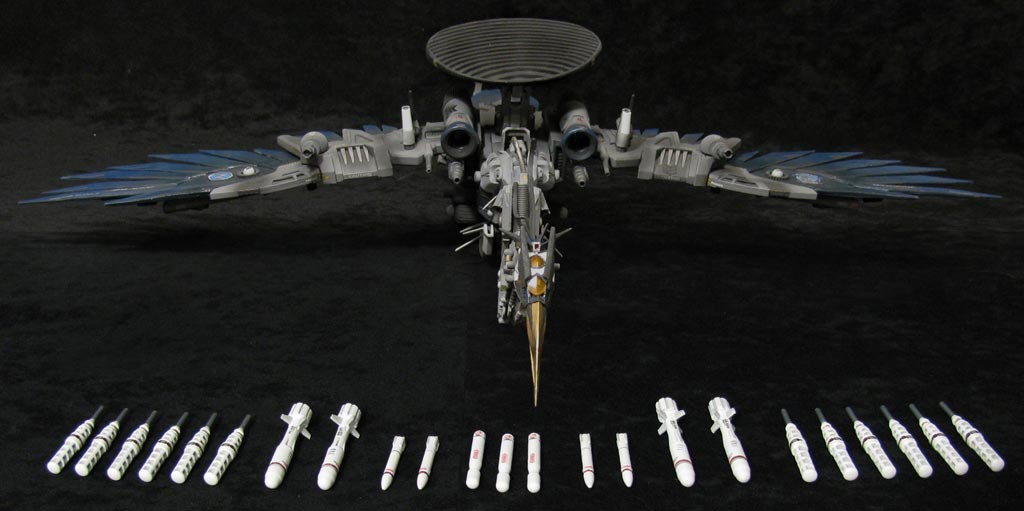


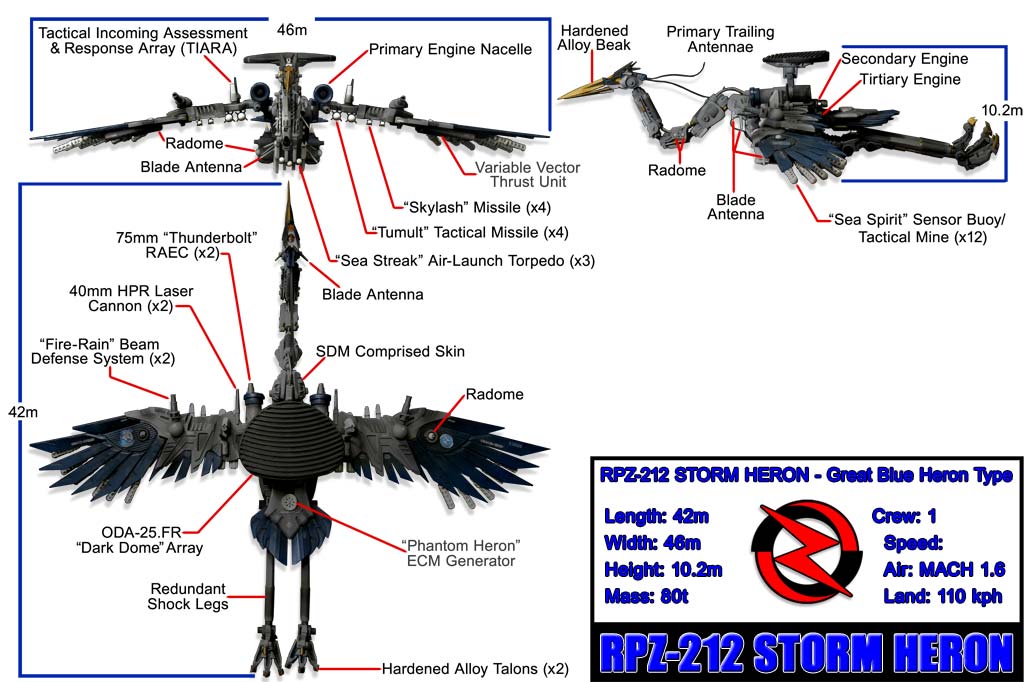













THE WINGS
With the neck and legs stretched, and the tail feathers cut, the wings looked absurdly small. I had planned to remove the feathers from the get-go (guys... feathers... on a frickin' war machine?!) I build a new base to replace the feathers and then use the cut tail feathers (removed to make the tail resemble a heron rather than a peacock) to extend the wings. Still not good enough! Finally, use Jet Falcon wings as another extension, this time between the shoulder and the elbow. I filled in the underside of the Falcon wings with grooved card styrene. In the end, the wings are more than twice the span of the Rainbow Jerk, and four times as heavy... and that is before the ordinance was added!


RPZ-212-A Assault Heron
The RPZ-212-A Assault Heron loses the dorsal radome array and its theater tracking ability in favor of defense cannons and a much greater ordinance payload, changing the Heron into a high altitude bomber. Four medium class laser guided bombs are added to the standard load, and the four air-to-air missiles are replaced with 18 high-low silhouette-seeker light missiles. For added effectiveness, the torpedo load has also been doubled. It also wields double defense cannons, one above and one below each wing. The lack of sensor buoys grants the -A superior maneuverability.
RPZ-212-E Ghost Heron
The 212-E Ghost Heron offers up most of its payload capacity for stealth and electronic warfare capabilities; it can actually seize control of an enemy’s weapon guidance system and redirect a warhead back at a new target, including the origination unit. It has four TIARA units and the underwing anti-air missile racks have been replaced by four tracking radomes. For weapons, the Ghost is reduced to only 2 each Skyslash, Tumult and Sea Streak weapons.
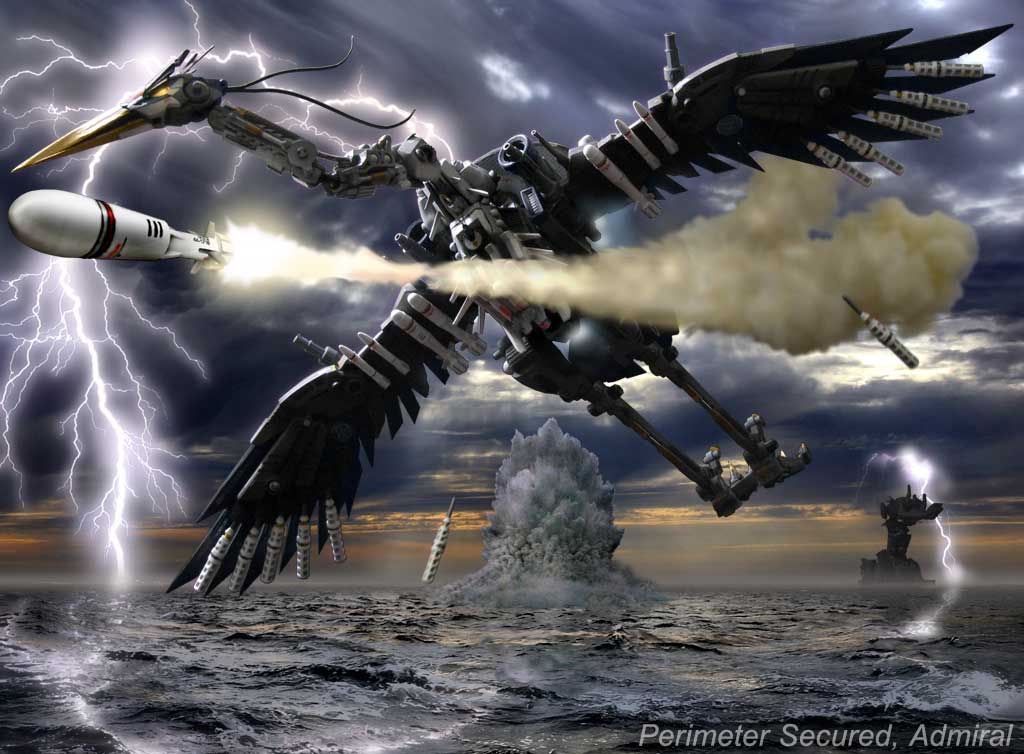
ENGINE CLUSTERS
I wanted something to make big, powerful-looking external engines, but couldn't find any Zoid parts that would do the job. Using my experience from the Siege Tortoise, I decided to take apart a pair of soft soap pumps for the compressor housing. These were capped by toothpaste tube caps, drilled out, to form functional-looking nozzles. The inlet bells were made using another part from the pumps, and mounted inside of it was a forward wheel from a G1 Transformers Grapple, which made very effective-looking armored compressors. The middle of the engines were too narrow, so I bulked them up using soft plastic ballpoint pen grips. Finally, a mounts were made out of video tape parts. The soft soap pump internal parts became the secondary engine nozzles, which were mounted to the back of the Jerk's shoulders. Beneath these I fitted a pair of engine bells from a small Gundam model.
LEG DETAILS
I wanted to make this build solid, so I filled in the back of every piece with styrene card. The inner thighs also had power boxes build onto them and a shaved rubber bolt were added for detail. I added working, metal hydraulic shocks to the shins and knees. For the shin, polystyrene tubes were used for hydraulic cylinders, steel video tape guide rollers were used for the pistons. Around there are brass ballpoint pen springs to function as shocks. The heel hydraulics required polystyrene sleeves to be inserted into the pen barrel; these allow the polished paneling nail pistons to slide. Each nail is run through another brass spring and is capped with a steel washer. The last detail I added was a "flex cap" for the toes. The nature of the build (and the scale) made it perhaps not impossible but REALLY unlikely that I would build working hydraulics for the toe flexors. But the toes had to be held upright in flight mode. I decided to design a plate to slip into the gap between the Jerk feet and the Aerosaurer toes. Each of these panels is mounted with three simulated hydraulics. These were made with pieces of sprue tree for the cylinders and, believe it or not, rubber gum massagers from a toothbrush; these were used for their ability to flex and hold the parts in place. And it's good for hygiene!
HEAD & FLEXIBILITY
The crest of the Rainbow Jerk was removed to make way for a more heron-like crest made from Gundam parts. These formed a crown of blade antennae that complimented both the look of a heron and the antennae found on modern military aircraft. Two flowing "feather" antennae were added through the old crown socked to simulate the trailing head feathers seen on herons. These are zip-ties. The eyes of the Jerk were removed and the sockets behind them were drilled out, making them into true windows. The workings of the inner neck had to be reworked for a ball joint. The original beak parts were used as anchors for a scratch built beak similar to the long, knife-like beak of the real heron. The neck flexibility is shown here, but, despite its agility, it never truly achieved the positions I hoped it would. That would simply have required too much jointing. Better luck next time... maybe I could make a crane? All of the details and additions made for a heavy unit, so some of this weight was compensated for by threading a silver necklace through the open pen tubes, which were snugged up using glue. When dried, it formed a gasket that allows the cable to slide but still holds up the head.
A COMPLETE RE-DESIGN
I decided to use the Rainbow Jerk tail feathers rather than cut all new pieces because 1) I wanted to use as much of the old Zoid as possible and 2) there were design details I wanted to retain for the new wings. The feathers were arrayed using photos of the real bird. Topside details were added; the TIARA targeting antennas, defense ball turret on the elbow, grooved vented panels and a Diablo Tiger plastic bullet was set within a drilled out plastic cog from a Killer Dome to form a radome array. It was important that the Storm Heron have a realistic weapon load and retain wing functionality, which seriously impacted the design. Here you can see the completed design.
FULL ORDINANCE
More weapons needed! When I first conceived of the idea of Storm Heron, I had already decided to use a Bamburian's missiles as sensor buoys. I knew I didn't want to use them as missiles or torpedoes because, let's face it, they are a skeletal structure full of holes. I didn't want to fill them all in! I did, however, fill in the four holes in the raised section to give the buoys a more realistic feel. I used Gojulas bolts to mount the buoys because 1) they look like turbines and 2) I have a lot of them! I also elected to mount them at a slight downward angle, drilling up into the wing through the black caps. The angle was chosen purely to add interest, making them appear almost as feathers rather than missiles or torpedoes. These are arrayed around more Bamburian parts made into a bank of maneuvering thrusters. These were actually very hard to shape, have had much of the back side completely sanded off and capped with more styrene to make the unit solid. The socket in these parts worked perfectly to fit another radome. The back ends of the Cannon Spider missiles were then turned around and drilled out to make a trio of torpedoes to mount beneath the body. More Gojulas caps fell to the saw to make the pieces to hold the torpedoes into their slots. Finally, I wanted all of the ordinance to be removable, like on Dreadwing. This habit of mine caused me fits on Storm Heron!
A.W.A.C.S. "Dark Dome" RADOME
The radome can lower between the back and tail when not in use or when the Heron is standing. It also allows the dome to be held level while standing. The hydraulic piston actually slides up to a quarter of an inch, but to maintain strength it locks into a square pit in the back just before the tail. I added the yellow cap because, hey, it looked really Zoid-like. :D
PRIMARY RADOME; MAKE IT WORK!
Half way through the build I decided to add the primary radome. Originally I was going to mount an aft communication station, but I had a broken radio with a large speaker that just had to be used for this! The radome is solid-feeling, heavy, and one of my favorite pieces of the build. The dome is built on an Elephander trunk unit, and I wanted to use the flexibility of that part. I made a hydraulic for the piece out of brass tubing and some interesting parts cut from a Deep Diver Blox sprue, these are fashioned to a nylon hinge. A second nylon hinge passes through a slot cut in the back plate, which allows the whole radome to be lifted free.
PUTTING IT ALL TOGETHER
This was the first assembly of the completed build. Just looking at it makes my head spin, since almost every color represents a different kit or source of parts. Posing the Heron is a task, as it is covered with moving parts, removable ordinance, springs, cables, ball joints, and the only solid parts are bristling with thin blade antennae. While not the largest build I have done, it is one of my most detailed.

PRIMED HERON
As with any custom, once the primer goes on, you start to see if you have the makings of a winner. The grey draws it all together, removing the distractions of colors and really showing if your forms blend or conflict. At this stage I knew I had a contender... as long as I didn't break it or kill it with a terrible paint job. Still, I was happy with the more angular shapes and realistic feel of the build.

A STRIKING SIGHT
The underside shots made me nervous... would all the ordinance work well together? Will it just look like a bunch of chunky parts? In the end I feel that I did achieve the real heron look, more or less, though the head appears a little small to me. Still, it holds that "predatory fishing bird" look well, and seems threatening enough for its job. I also noted that the primed head looks very much like a skull since it was painted with the eye glass out!

FINAL DETAILS
Almost as an aftermath, I decided I would not avoid creating a detailed cockpit, like I did with the Dreadwing. I returned to my Fusillade roots and took parts from a 1/48 scale Huey Cobra helicopter and converted them into 1/72 scale cockpit controls. There is an over-leg console, an over-shoulder console, and an over-shoulder emergency ejection handle. These remained removeable from the cockpit even in the final version. To fit the HMM pilot, a contoured seat had to be dremeled out. The final image, above, is a paint concept made by using Photoshop on a picture of the primed model. The color pattern matches those of photographs I collected of the great blue heron... with the addition of engines. :P
THE BUILD
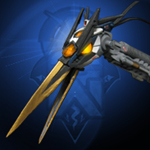

WINNER: Zoids Poison Custom Contest - 2010 ~ WINNER: Grand Prix 2010 Custom Contest
1st Place Winner
Zoids Poison 2010
Custom Contest

Grand Prize Winner
Grand Prix 2010 Custom Contest

